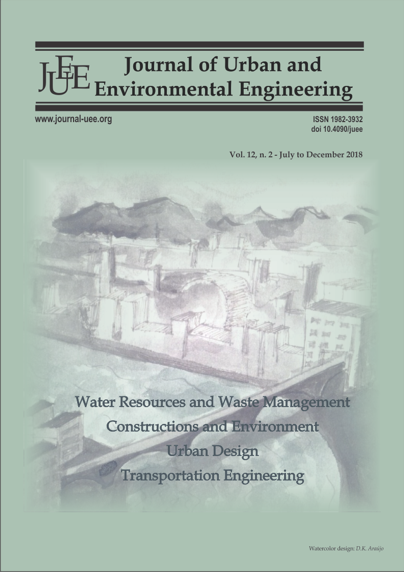SIMULATION OF SURFACE WATER POLLUTION IN A WATERSHED SUBJECT TO PROGRESSIVE URBANIZATION
DOI:
https://doi.org/10.4090/juee.2018.v12n2.293-307Keywords:
Pollutant load, diffuse pollution, progressive urbanization, Land use and occupationAbstract
The large alterations in land use and occupation associated with progressive urbanization tend to increase the direct and indirect impacts on the water quality of streams and rivers. Relying on various land occupation scenarios in a watershed subject to progressive urbanization, considering a horizon of 30 years, this study estimated the pollutant loads of all its sub-basins, simulated the dispersion of pollutants along its main watercourse and estimated the pollutant loads at the basin’s outlet. The method used to estimate the pollutant loads was adapted from that proposed by Schueler (1987), with inclusion of the Soil Conservation Service method (SCS, 1973) to estimate the surface runoff or excess rainfall. The dispersion of pollutants in the principal stream was simulated by numerically solving the advection-diffusion equation, after discretization by finite differences, employing a computational code implemented in the Visual Basic language. The ranking of the pollutants in decreasing order of gross annual loads for the 30-year scenario showed the highest production of suspended sediments (510 to 4,882 metric tons/year), followed by BOD with 42 to 172 tons/year and nutrients (13 to 62 tons/year for total nitrogen and 6 to 29 tons/year for nitrite and nitrate). Zinc accounted for the smallest discharge, with 1.7 to 7.9 tons/year. In turn, in the ranking by the correlation coefficient between the loads of each pollutant and the advance of urban occupation, represented indirectly by the number curve (NC) parameter, BOD was most sensitive to urban expansion, since it had the strongest correlation with the number curve (about 41%). Total suspended solids (TSS) and zinc were less influenced by the occupation processes of the watershed, although they were closely correlated with rainfall. In general, the method used in this study can help planners make decisions about urbanization guidelines and zoning rules. The results indicate the importance of establishing policies for moderate occupation of watersheds and reduction of the diffuse pollution caused by urbanization.Downloads
Download data is not yet available.
Downloads
Published
2019-02-27
Issue
Section
Articles




